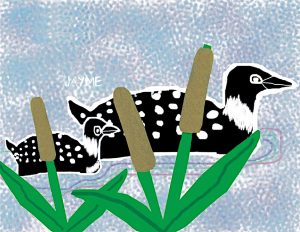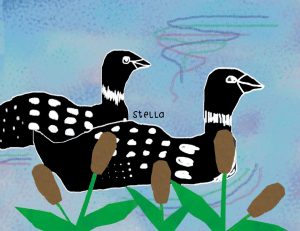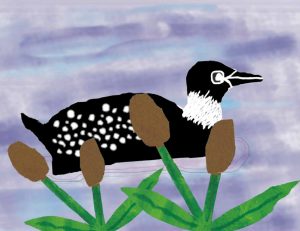Loon Lake Lesson Plan
Students will create a loon using a paint resist technique to be placed on a watercolor rendition of a lake surface.



Process
- Discuss loons and other birds that may be found around water.
- Look at pictures of loons and discuss their characteristics. Discuss the different shapes involved in drawing a loon.
- Have the students begin drawing their loon on white scrap paper with a white crayon, press down hard (the loon may be sketched lightly with a pencil)
- Remind students that any lines drawn in the white crayon will stay white.
- The outline of the bird, they eye, spots or markings and any definition of the beak should all be drawn in white.
- Wash the white crayon loon with black watercolor paint.
- The white crayon will resist the black paint.
- Set the loon aside to dry.
- Paint the background.
- The heavy white paper is going to be your background.
- Stress to the students to use “water” type colors (greens, blues, purples).
- The paint should be applied to the paper in a swirling manner to give the “water” a sense of movement.
- Set aside to dry.
- Trim your dried loon(s) from the scrap paper.
- Decide on the possible addition of plants, cattails, marsh grass, etc.
- Draw and cut out any plants (construction paper or tissue paper may be used).
- Lay out your loons and plants on your background to ensure proper placement.
- Placing the plants in front of the loons will give your artwork more dimensions.
- Once placement has been decided, glue the pieces firmly into place.
- Add crayon lines to detail the movement of the water.
- Moving water will ripple around any objects.
- The final step is to sign your masterpiece. Use a fine tip black marker and sign at least 1” away from the paper edge. Record student name, grade, teacher/class on the back in pencil.
Time Needed:
2 classes
Materials
- 8 1/2″ x 11″ white art paper
- white scrap paper
- scissors
- watercolor paints
- brushes and/or sponges
- crayons
- glue
- fine tip black marker
- construction or tissue paper scraps (browns & greens)
- pictures of lake scenes
- pictures of loons

